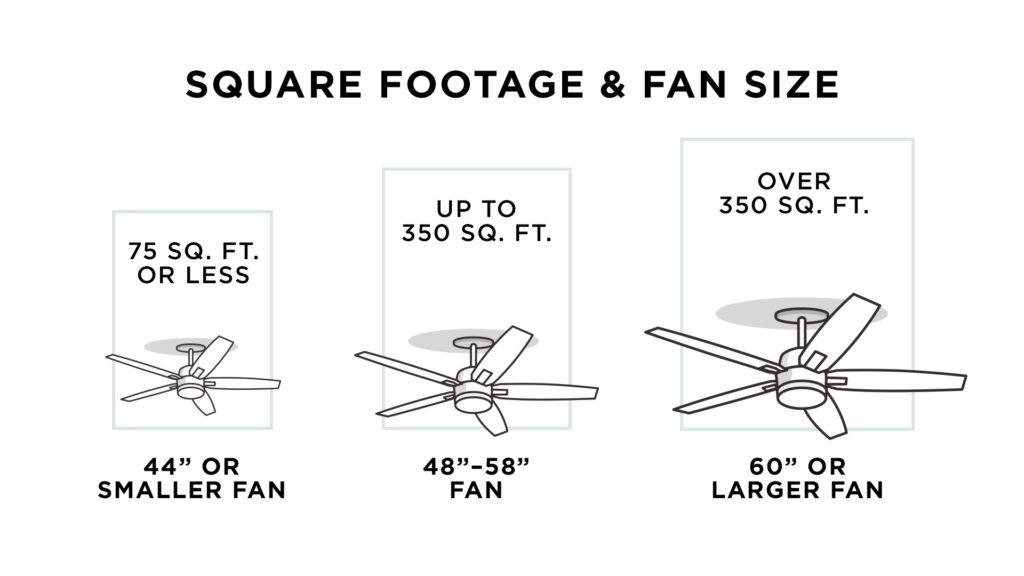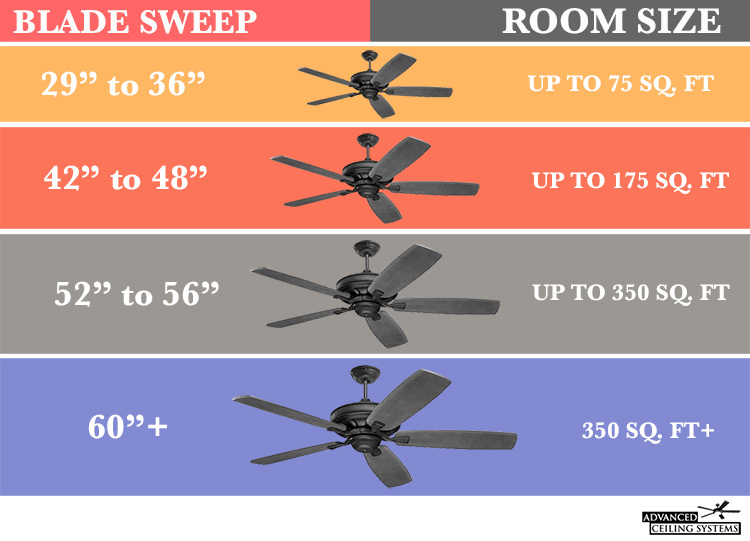Determining the Right Size

Choosing the right ceiling fan size for your small bedroom is crucial for optimal airflow and comfort. A fan that’s too small won’t effectively circulate air, while one that’s too large can be overwhelming and create drafts.
Fan Size and Room Size
The size of your ceiling fan should be proportionate to the size of your room. This ensures the fan can effectively move air throughout the space. A general rule of thumb is to select a fan with a blade span that is roughly one-third the width of the room. For example, a 10-foot wide bedroom would typically require a fan with a blade span of 3-4 feet.
Airflow and Fan Size
Airflow is the amount of air a fan moves in a given amount of time. It’s measured in cubic feet per minute (CFM). The CFM of a fan is directly related to its size, with larger fans generally having higher CFM ratings. A larger fan can move more air, making it more effective in cooling larger rooms. However, in a small bedroom, a smaller fan with a lower CFM rating can still be sufficient for adequate air circulation.
Fan Size Guide
Here’s a simple guide to help you choose the appropriate ceiling fan size for your small bedroom:
| Room Size (sq ft) | Fan Size (inches) | Blade Length (inches) | Recommended RPM |
|—|—|—|—|
| 75-100 | 36-42 | 14-16 | 150-200 |
| 100-150 | 42-48 | 16-18 | 175-225 |
| 150-200 | 48-52 | 18-20 | 200-250 |
Note: RPM stands for revolutions per minute. Higher RPM generally means faster fan speed and greater airflow.
Types of Ceiling Fans for Small Bedrooms
Choosing the right ceiling fan for your small bedroom is crucial for creating a comfortable and stylish space. Not all fans are created equal, and some types are better suited for smaller rooms than others. Let’s explore the different types of ceiling fans available and how they can enhance your bedroom’s ambiance.
Flush Mount Ceiling Fans
Flush mount fans are designed to sit close to the ceiling, making them ideal for rooms with low ceilings. Their compact size and slim profile minimize visual clutter, allowing them to blend seamlessly with the room’s decor. These fans are known for their quiet operation and efficient airflow, providing effective cooling without overwhelming the space.
Flush mount fans often feature smaller blades compared to standard fans, which helps to optimize airflow in smaller rooms. They also come in a wide variety of styles, from modern and minimalist to traditional and ornate, making it easy to find one that complements your bedroom’s aesthetic.
Flush mount fans are a great choice for small bedrooms with low ceilings, as they minimize visual clutter and offer efficient cooling.
Semi-Flush Mount Ceiling Fans
Semi-flush mount fans offer a balance between the compact size of flush mount fans and the larger profile of standard fans. They sit a few inches away from the ceiling, providing a slightly more substantial presence while still being suitable for rooms with moderate ceiling heights.
Semi-flush mount fans often feature a slightly larger blade span than flush mount fans, allowing for greater airflow and improved cooling. They also come in a variety of styles, offering a good balance between functionality and aesthetics.
Semi-flush mount fans are a good option for small bedrooms with moderate ceiling heights, offering a balance between size and functionality.
Standard Ceiling Fans
Standard ceiling fans are the most traditional type of ceiling fan, featuring a longer downrod and larger blades. While they are generally best suited for larger rooms, they can still work well in smaller bedrooms with high ceilings.
Standard fans often have a greater blade span, resulting in more powerful airflow and better cooling. They also come with a wider range of features, including multiple speeds, light fixtures, and remote control options. However, their larger size can be overwhelming in smaller bedrooms with low ceilings.
Standard ceiling fans are best suited for larger rooms with high ceilings, but they can still work in smaller bedrooms if there is enough clearance.
Additional Considerations: What Size Ceiling Fan For Small Bedroom

Choosing the right ceiling fan for your small bedroom goes beyond just size and style. It’s essential to consider other factors that can significantly impact the fan’s performance and your overall comfort. Let’s delve into some key aspects to help you make an informed decision.
Fan Speed and Noise Levels
Fan speed plays a crucial role in determining airflow and noise levels, especially in a small bedroom. Higher speeds generate more powerful airflow, effectively circulating air and providing a cooling breeze. However, this also comes with increased noise.
In a small bedroom, it’s important to find a balance between effective airflow and acceptable noise levels. Look for fans with multiple speed settings, allowing you to adjust the airflow based on your needs and preferences. Consider fans with whisper-quiet operation, particularly if you’re sensitive to noise or prefer a peaceful sleep environment.
Room Height, Ceiling Material, and Personal Preferences, What size ceiling fan for small bedroom
Several other factors can influence your ceiling fan choice.
* Room height: For smaller bedrooms with low ceilings, a smaller fan with a shorter blade span is recommended to prevent the blades from hitting the ceiling or creating a cluttered appearance.
* Ceiling material: The type of ceiling material can affect the installation process and fan stability. For example, a fan with a heavier motor might be necessary for a vaulted ceiling or a ceiling made of drywall.
* Personal preferences: Ultimately, your personal preferences should guide your decision. Consider factors such as style, color, and design elements that complement your bedroom’s decor.
Installation and Maintenance
Installing and maintaining a ceiling fan is a straightforward process, but it’s crucial to prioritize safety and follow best practices.
* Safety: Always disconnect the power to the circuit before working on the fan. Use appropriate tools and safety equipment, and follow the manufacturer’s instructions carefully.
* Best practices: Ensure the fan is securely mounted to the ceiling joist, and check the fan’s balance regularly. Clean the blades and motor periodically to ensure optimal performance and prevent dust buildup.
What size ceiling fan for small bedroom – A small bedroom often benefits from a smaller ceiling fan, ensuring optimal airflow without overwhelming the space. A dark blue and orange bedroom, with its vibrant energy, might call for a fan with a touch of modern design, like a sleek, minimalist model.
Ultimately, the perfect ceiling fan for your small bedroom depends on your personal style and the overall aesthetic of the room, so choose one that complements the bold and vibrant design of a dark blue and orange bedroom.
Choosing the right ceiling fan for a small bedroom is crucial for optimal airflow and comfort. A smaller fan, with a blade span of 42 inches or less, is ideal for smaller spaces, ensuring efficient air circulation without overwhelming the room.
If your bedroom is painted in a calming grey and powder blue bedroom color scheme, a white or brushed nickel fan will blend seamlessly, adding a touch of sophistication to the space. A ceiling fan in a small bedroom should be proportionate to the room’s size, creating a balanced and functional environment.

